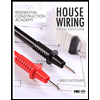
Concept explainers
In a work situation where an electrician’s hands get wet while operating a 120-volt, corded drill, which of the following would be true? (Objective 1-1)
a. Body resistance increases, and any shock would be mild.
b. Body resistance remains the same, and there is no danger as Long as rubber boots are worn.
c. Body resistance is substantially decreased, and severe shock could occur.
d. There is no danger as Long as a three-prong plug is used.
The true statement for the situation where an electrician’s hands get wet while operating a
Answer to Problem 1RQ
Option (c) Body resistance is substantially decreased, and severe shock could occur.
Explanation of Solution
Introduction:
According to the Ohm’s law, the relation between the current, voltage, and resistance is given by,
Here, the current is in amperes, voltage is in volts, and resistance is measured in Ohm’s.
The flow of current through any material depends upon the resistance provided by the material. The higher is the circuit resistance, the lower the current flow that a voltage can push through the circuit and vice-versa.
Dry skin offers much more resistance in comparison to the wet body. This means that higher the resistance value, the more opposition to the current flow through the body.
The following table shows the value of resistance with respect to the different conditions:
| Skin Condition | Resistance |
| Dry skin | |
| Sweaty hands | |
| In water |
As shown in the above table, the value of resistance for wet hands is very less so if in a work situation where an electrician’s hands get wet while operating a
As shown in the above table, the value of resistance for wet hands is very less, so the shock will not be mild. Thus, option (a) is incorrect.
Therefore, the body resistance will not remain the same if the hand gets wet. Thus, option (b) is incorrect.
The electrician will always be in danger if his hands are wet. Thus, option (d) is incorrect.
Conclusion:
Therefore, the Option (c) Body resistance is substantially decreased, and severe shock could occur is best suitable answer for the given statement.
Want to see more full solutions like this?
Chapter 1 Solutions
Residential Construction Academy: House Wiring (MindTap Course List)
- Directions: Circle T to indicate true statements or F to indicate false statements. The higher the resistance in an electrical circuit, the lower the amount of current that can flow in the circuit. (Objective 1-2)arrow_forward2. A shell leaves a mortar with a muzzle velocity of 150 m/sec. directed upward at 60o with the horizontal. Determine the a) total time of flight. b) Maximum height it reached. c) Location of the shell after 20 sec it was fired d) its resultant velocity 18 sec. after it was fired.arrow_forwardA ground resistance meter is used to determine the amount of resistance__________.(Objective 4-7) a. through a grounding electrode to the earth b. though a grounding electrode to the metal frame of an electrical cabinet c. from one end of a grounding conductor to the other end d. from a grounded conductor to the eartharrow_forward
 Residential Construction Academy: House Wiring (M...Civil EngineeringISBN:9781337402415Author:Gregory W FletcherPublisher:Cengage Learning
Residential Construction Academy: House Wiring (M...Civil EngineeringISBN:9781337402415Author:Gregory W FletcherPublisher:Cengage Learning
